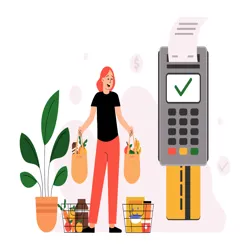To better understand the benefits of dual pricing, it’s essential to understand the current state of payment processing. The cost of processing credit card payments is increasing for many business owners throughout the United States. News reports suggest that the major card network Mastercard has been increasing network “assessment” fees since April 2024.[1]Bloomberg Law. “Mastercard Still Raising Some Fees After Retailer Settlement.” Accessed September 11, 2024 Currently, Visa and Mastercard are in the process of settling a lawsuit over their excessive increase in interchange fees over the years and the financial burden these fees have caused. Whether or not these card networks are required to create a more merchant-friendly fee structure remains to be seen. For now, it’s essential for businesses to find ways to lower the fees charged with every swipe…or avoid processing costs entirely. Dual pricing credit card processing is a way to do just that.
You may consider this pricing model if your business loses significant revenue due to credit card processing fees. With dual pricing, a newer and more compliant version of cash discount pricing, cash-paying customers pay the merchant’s list price while credit-card-using customers pay the list price plus a percentage that covers the processing fees (around 4%). This offers customers the convenience of paying with cash or a card while saving businesses the processing fees. Before implementing this innovative pricing model into your business, it is essential to understand this pricing model inside and out before changing your current pricing strategy.
This guide explores dual pricing, how it compares to other pricing models, its advantages and disadvantages, and other related topics. Read ahead if your business is seeking lower credit card processing fees!
What is Dual Pricing?

As its name suggests, dual pricing is a pricing model offering two different pricing options to customers. With this pricing model, cash-paying customers only pay the list price, while card-paying customers pay the list price plus 4% more. The dual pricing model is popular with businesses seeking reduced exposure to credit card processing fees. When implementing this pricing model, your business doesn’t have to worry about changing its displays or price lists. All that would be needed is obtaining equipment or invoicing software that can easily display two prices simultaneously (one for card and one for cash). As long as this pricing model is appropriately conveyed to customers, i.e., showing both a cash and card price simultaneously, this is a simple strategy to enforce overall.
Unlike surcharging (a program that solely applies to credit card transactions, is legal in only specific states, and comes with various credit card restrictions), dual pricing is a nationwide pricing model for both credit and debit cards. Before implementing this pricing model, however, your business must clearly communicate this option to customers, avoiding terms that may imply surcharges on other payment methods. The most basic rule: when presenting the price of an item, always have a cash price and credit card price displayed, whether it’s on a terminal, a receipt, or an invoice. If uncertain, consult legal counsel to confirm compliance and mitigate potential legal risks. Adhering to transparent and lawful practices is essential to prevent legal issues and build customer trust.

Dual pricing vs cash discount
Dual pricing and cash discount pricing refer to similar but very distinct pricing models. Both result in customers benefiting from using cash instead of cards to purchase products or services. However, both models operate differently. Dual pricing allows customers to use any payment method they want while allowing merchants to save on processing fees. Cash discount pricing is an actual list price discount provided to incentivize customers to make cash payments. Either way, both these pricing models are legal in all 50 states.

Dual pricing vs surcharging
Both dual pricing and surcharge pricing are strategies merchants use to pass processing fees onto the customer. However, they operate from two different directions. The former offers customers the flexibility to pay only the list price when using cash. It incentivizes cash payments and can improve businesses’ cash flow. However, if a customer chooses to use a credit card or even a debit card to complete a transaction, merchants can defer the processing fees to the customer through the dual pricing model.
On the other hand, surcharge pricing involves adding an extra fee to the standard price, typically to cover transaction fees. While dual pricing encourages cash payments, surcharge pricing aims to offset the additional costs associated with credit card payments only. Also, surcharging is illegal or heavily regulated in some states, so it’s a much riskier option than using a dual pricing model. It’s also worth noting that Visa is ramping up its enforcement on merchants who add surcharges to credit card transactions, which could lead to significant fines.[2]The Financial Technology Report. “Visa Intensifies Enforcement on Merchant Surcharges.” Accessed September 11, 2024
Advantages and Disadvantages
As with any pricing strategy, there are pros and cons associated with the dual pricing model. Let’s explore the benefits and drawbacks in more detail below:
Pros
- Encourage Cash Payments: If your business wants to increase the number of cash payments it receives, offering dual pricing is one of the most effective options. However, it’s critical to advertise your use of this pricing model effectively; otherwise, customers may not bring cash to your store.
- Reduce Exposure to Payment Processing Fees: While the average payment processing fee is less than 3%, this figure can quickly eat into your margins if many of your customers pay with credit cards.[3]Forbes Advisor. “Credit Card Processing Fees (2024 Guide).” Accessed September 11, 2024 Implementing dual pricing encourages customers to use cash, ensuring credit card fees don’t destroy profits. Also, if your customers choose to use credit cards, they pay the fees for you in the total price.
- Provide Options to Your Customers: Passing payment processing costs onto customers without them knowing the benefits of using cash hurts customer loyalty. By offering dual pricing, your business allows your customers to make an informed choice before paying.
Cons
- Negative Customer Sentiment: Dual pricing models can result in potential negative sentiment from card-paying customers, who may feel they are being discriminated against for their payment preferences. Considering around 63% of consumers are more likely to shop at merchants with their preferred payment method, your business may lose customers if they feel they are being penalized for being card-paying customers.[4]CIO. “Consumers Want More Payment Flexibility in Their Shopping Experience.” Accessed September 11, 2024
- Regulatory Burden: While dual pricing is legal in all 50 states, this doesn’t mean you don’t need to comply with the rules and regulations surrounding this pricing model. Likewise, rules are subject to change.
- Increased Administrative Load: A poorly implemented dual pricing program may lead to excessive administrative tasks. When using this pricing model, it’s essential to convey both pricing options to customers through advertising, signage, or other methods. This can add an additional burden on busy merchants. A good way to counteract this issue is using a payment processor and software or hardware specializing in dual pricing.
What to Consider Before Implementing
Implementing a new pricing model into your business requires attention to detail. Below, let’s explore some factors to consider before switching to dual pricing:

Does Your POS Provider Offer Dual Pricing?
Firstly, it is critical to check if your current POS provider offers dual pricing. Otherwise, the process may be more trouble than it’s worth. You must work with a POS provider with automated tools for this pricing model.

Is Your Merchant Service Provider Charging Too Much?
If reducing payment processing fees is at the top of your business’s priority list, it may be due to your merchant service provider’s pricing. By choosing a merchant service provider with lower processing fees, your business retains more profit without using creative pricing models like dual pricing or surcharging. Many payment processors offering flat-rate processing fees, such as Stripe and PayPal, often charge excessive markups. With this in mind, a merchant account provider is likely a better option.

How Many of Your Customers Pay in Cash?
Lastly, assess how many of your customers currently pay in cash before practicing dual pricing. If your business only receives a small proportion of payments in cash, a dual pricing model may not be worth it. If customers prefer credit card payments to cash, implementing dual pricing may result in negative customer sentiment and damage your business.

Are Your Staff Trained to Implement a Dual Pricing Program?
Ensure all your staff understand the dual pricing model and how to apply it during checkout. If they don’t, they may advertise dual pricing incorrectly and violate regulations.

Do You Have Competitors Ready to Take Advantage of Your New Pricing Model?
Strong competition may deter the implementation of a dual pricing program because it could lead customers to choose competitors that offer more attractive pricing structures. In a highly competitive market, businesses may hesitate to introduce a pricing strategy that could potentially drive customers away, especially if competitors don’t adopt similar practices.

Do You Have an Effective Communication Strategy for Your Dual Pricing Program?
Clear communication is critical when offering dual pricing to customers to avoid confusion and build trust. Transparent messaging ensures customers understand the dual pricing incentive, reducing the likelihood of misunderstandings or negative perceptions. Strong communication helps maintain positive relationships and ensures customers are aware of the benefits associated with dual pricing, contributing to the overall success and acceptance of the pricing strategy.
Get Started with Dual Pricing Merchant Services

Dual pricing is a suitable option for businesses that want to incentivize cash payments and reduce exposure to credit card processing fees. While this pricing model requires a clearer communication strategy, it’s legal in all 50 states and may work for businesses with a cash-paying customer base. If you want to implement dual pricing, it’s critical to find a merchant service provider and POS software platform with dual pricing options.
Alternatively, switching to a more affordable merchant service provider may also save your business money and help avoid the need for dual pricing. If your business currently uses a payment service provider (PSP), such as PayPal or Square, you may be overpaying for credit card processing. By partnering with a merchant account provider like PaymentCloud, your business will access lower payment processing costs, increased payment flexibility, and dedicated support!






